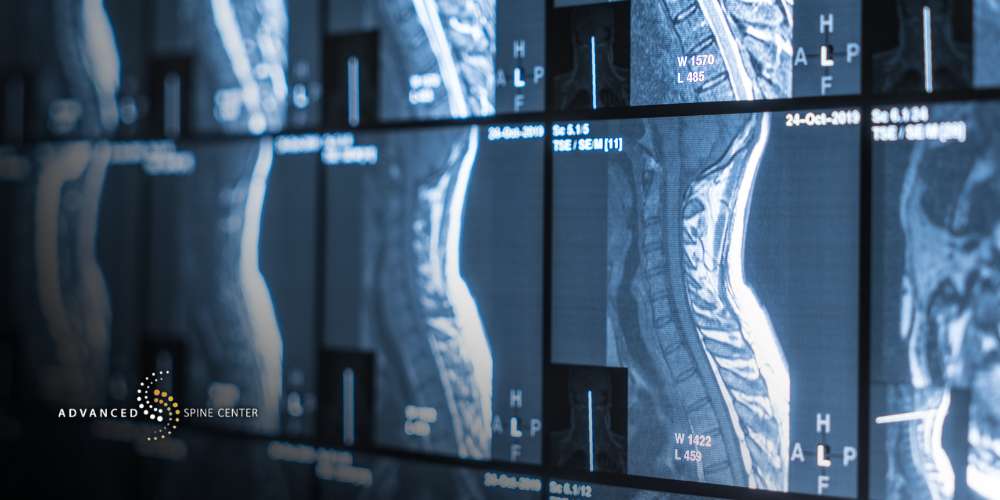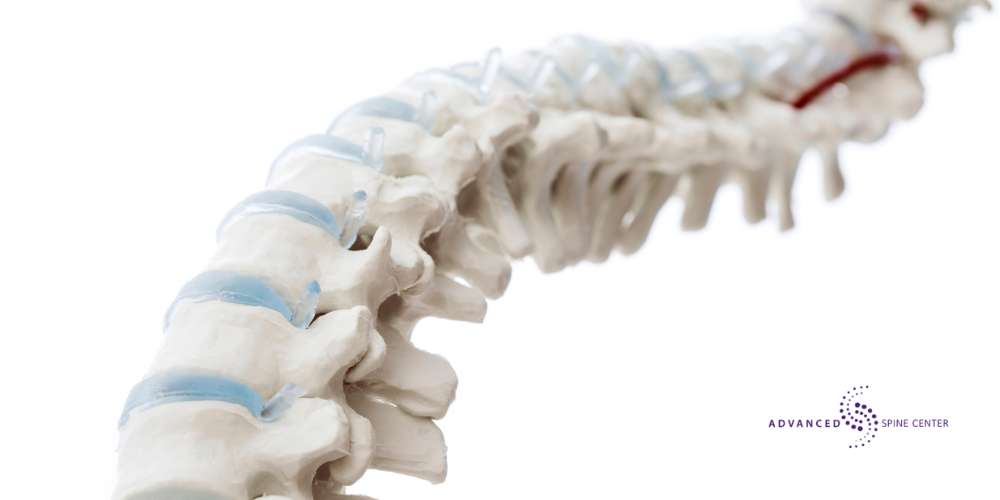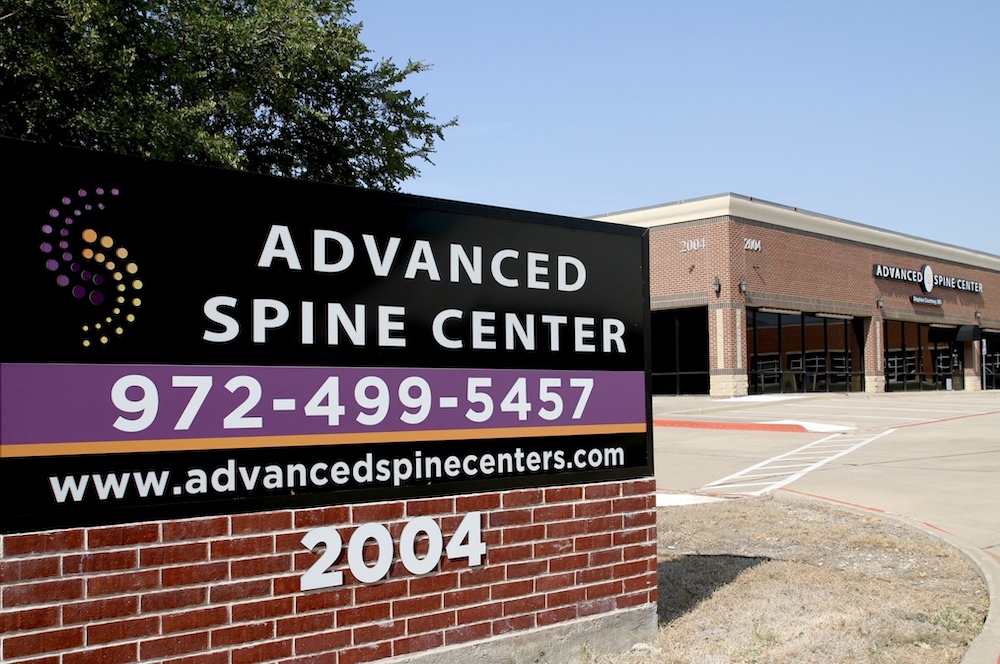Specialties

At the Advanced Spine Center, we specialize in vertebroplasty surgery in Plano, TX, to help patients suffering from vertebral compression fractures, and other spinal conditions that cause severe pain and limit mobility.
Board-certified spine surgeon Stephen P. Courtney, MD, leads a team of skilled medical professionals committed to helping patients find solutions to relieve pain. They focus on improving quality of life through minimally invasive procedures, including percutaneous vertebroplasty and kyphoplasty. We understand that spinal injuries can be debilitating, and we are here to guide you through every step of your recovery.
If you’re struggling with back pain from a vertebral compression fracture or another painful spinal condition, don’t wait to seek relief. Contact the Advanced Spine Center in Plano, TX, today to discuss your vertebroplasty treatment options. Our experienced team is here to help you regain mobility and live pain-free. Call us at (972) 499-5457 to schedule your consultation.
What Is Vertebroplasty?
Vertebroplasty is a minimally invasive procedure designed to treat vertebral compression fractures in the spine, particularly those caused by osteoporosis, metastatic disease, or trauma. These fractures often result from weakened bones due to osteoporosis or cancer spreading to the vertebral bodies, leading to a vertebral compression fracture.
The procedure involves the percutaneous injection of bone cement into the fractured vertebra, stabilizing it and alleviating severe pain. By reinforcing the compressed vertebral body, vertebroplasty helps restore spinal stability and allows patients to resume daily activities with reduced discomfort.
Vertebroplasty is particularly beneficial for patients who have not responded to conservative treatments such as bed rest, physical therapy, or pain medications. It offers immediate pain relief for many suffering from painful vertebral fractures, enabling them to regain mobility and improve their quality of life. The procedure is also used to treat fractures resulting from spinal metastases, where cancer has spread to the spine, causing vertebral body collapse.
Vertebroplasty vs. Kyphoplasty
While both vertebroplasty and kyphoplasty aim to treat vertebral compression fractures and provide pain relief, they have distinct differences:
- Vertebroplasty stabilizes the fractured vertebra by injecting bone cement directly into the fracture site. It primarily prevents further vertebral collapse and provides quick pain relief.
- Kyphoplasty involves inserting a balloon into the collapsed vertebral body, inflating it to create space and potentially restore lost vertebral height before injecting bone cement. This can correct spinal deformities resulting from the compression fracture and may relieve pressure on the spinal canal, reducing symptoms associated with spinal stenosis.
The choice between vertebroplasty and kyphoplasty procedures depends on individual factors, such as the degree of vertebral body collapse, the presence of spinal deformity, and overall health. Our specialists will evaluate your specific case to determine the most appropriate treatment.
Percutaneous Vertebroplasty
Percutaneous vertebroplasty is performed through a small skin puncture, avoiding large incisions and minimizing surgical trauma. Under imaging guidance like fluoroscopy or CT scans, a needle is precisely guided into the compressed vertebral body. The bone cement used is often an acrylic surgical cement known as polymethylmethacrylate (PMMA), which hardens quickly to stabilize the fracture.
This technique reduces operative time and minimizes risks associated with open surgeries, such as excessive blood loss, infection, and fluctuations in blood pressure during surgery. It’s particularly beneficial for patients who may not tolerate more invasive surgical intervention due to age, osteoporosis, or other health conditions. Percutaneous vertebroplasty can also treat acute fractures resulting from trauma.
Pros and Cons of Vertebroplasty
Pros of vertebroplasty:
- Immediate pain relief: Many patients experience significant pain reduction shortly after the procedure.
- Minimally invasive: The procedure involves a small incision, reducing risks like blood clots and infection.
- Quick recovery: Patients often return to normal activities within days, reducing the need for prolonged bed rest.
- Stabilization of fractures: Helps prevent further vertebral body collapse and potential nerve root compression.
Cons of vertebroplasty:
- Risk of cement leakage: Bone cement may leak into surrounding areas, potentially causing nerve root compression or spinal cord compression.
- Possibility of new fractures: There’s a risk of fractures in adjacent vertebrae due to altered spinal biomechanics or underlying osteoporosis.
- Not suitable for all fracture types: Vertebroplasty may not be effective for chronic fractures or those with significant vertebral body collapse.
What Is Vertebroplasty Used to Treat?

Vertebroplasty treats painful compression fractures unresponsive to conservative treatments like bed rest, pain medications, or physical therapy. It’s particularly effective for an osteoporotic vertebral compression fracture, where decreased bone density leads to fragile bones. Osteoporosis can cause osteoporotic fractures in the spine, resulting in intractable pain and reduced mobility.
The procedure also manages painful vertebral compression fractures caused by metastatic disease, where cancer cells weaken the vertebral bodies, and aggressive vertebral hemangiomas, benign vascular tumors causing vertebral body collapse.
Vertebral Compression Fractures
Vertebral compression fractures occur when the vertebral body collapses, leading to severe pain and decreased mobility. These fractures can happen anywhere in the spine but are most common in the thoracic spine and lumbar spine.
Common causes include:
- Osteoporotic compression fractures due to weakened bones.
- Spinal compression fractures from trauma or metastatic disease.
- Acute compression fractures resulting from sudden injury.
Symptoms of a compression fracture may include back pain worsening with movement, limited spinal flexibility, and, in severe cases, nerve root compression leading to neurological symptoms like numbness or weakness in the limbs.
Early diagnosis and treatment are necessary to prevent complications like spinal deformities, spinal stenosis, or chronic pain. Diagnostic tools like X-rays, MRI, and nuclear medicine bone scanning help identify the exact location and severity of the fracture.
How Does Vertebroplasty Work?
Vertebroplasty stabilizes the fractured bone with bone cement. The injected cement fills spaces within the vertebral body compression fractures, binding the fracture fragments together. This stabilization prevents further vertebral body collapse and halts the movement of bone pieces that can irritate the spinal cord or nerve roots.
By securing the structural integrity of the vertebra, vertebroplasty alleviates pain refractory to conservative measures and allows the spine to bear normal loads again. Vertebroplasty also helps restore spinal alignment, reducing the risk of developing kyphosis or other deformities. Preventing the progression of the fracture also reduces the likelihood of complications like spinal canal narrowing and spinal cord compression.
What Is the Vertebroplasty Procedure?
During the vertebroplasty procedure:
- Preparation: The patient lies face down on the operating table. Local anesthesia is administered to numb the area, and sedation is provided for comfort.
- Needle Insertion: Using real-time imaging, such as fluoroscopy, the surgeon inserts a hollow needle into the compressed vertebral body.
- Cement Injection: A small amount of contrast dye may be injected first to ensure correct needle placement and assess potential cement leakage pathways. Bone cement is then injected under controlled pressure.
- Completion: The cement hardens within minutes, stabilizing the vertebra. The needle is removed, and a bandage is applied. No stitches are usually required.
The vertebroplasty procedure typically takes about one hour per treated vertebra and may be repeated for additional compression fractures.
How to Prepare for Vertebroplasty
Preparation for vertebroplasty involves a thorough medical evaluation, including diagnostic imaging like MRI or nuclear medicine bone scanning to locate vertebral fractures. Patients should:
- Inform the doctor of all medications, especially blood thinners like warfarin or aspirin.
- Adjust medications as directed to reduce bleeding risks.
- Monitor and manage blood pressure levels, as fluctuations can impact the procedure.
- Fast before the procedure if instructed.
- Arrange transportation post-procedure due to sedation effects.
- Discuss any allergies to contrast dyes or medications.
- Undergo pre-procedure blood tests to check clotting times and overall health.
What to Expect After Vertebroplasty
After vertebroplasty, most patients can expect a relatively quick recovery and significant pain relief within a few days—often within the first 48 hours. The procedure is minimally invasive, so many people are able to return home the same day. Some mild soreness at the injection site is common, but this usually resolves quickly.
Patients are typically encouraged to limit strenuous activity for a short time, but normal daily activities can often be resumed within a day or two. Follow-up care may include physical therapy, pain management, and imaging to monitor healing. Always follow your doctor’s instructions closely for the safest recovery.
Cement in Spine Recovery Time
Due to the minimally invasive nature of the procedure, vertebroplasty recovery time is typically short. Most patients can resume light activities within 24 hours, often experiencing immediate pain relief and functional recovery. Many can return to their normal routines, provided they follow their doctor’s guidelines to ensure proper healing. Engaging in recommended exercises and maintaining a healthy lifestyle can further enhance recovery outcomes.
What Are the Long-Term Effects of Vertebroplasty?
Long-term outcomes are typically positive, with lasting pain relief and improved mobility. However, managing bone health remains important to prevent further compression fractures in nearby vertebrae.
Some studies suggest a possible risk of new fractures in adjacent vertebrae due to increased stiffness in the treated area. Regular check-ups, exercise, balanced nutrition, and medications that support bone density are beneficial to reduce these risks.
How Long Does Vertebroplasty Cement Last?
The bone cement used in vertebroplasty is permanent. Once injected, it hardens and remains within the vertebral body indefinitely, providing durable stabilization. The cement maintains its structural integrity over time, helping to prevent recurrent collapse of the treated vertebra.
While the cement itself does not degrade, the surrounding bone may still be impacted by osteoporosis or degenerative conditions. Therefore, maintaining bone health is essential for the long-term success of the procedure.
Vertebroplasty Success Rate
Vertebroplasty has a high success rate in relieving pain caused by vertebral compression fractures:
- Clinical Studies: Success rates range from 75% to 90%, with many patients experiencing significant improvements.
- Factors Influencing Success: Overall health, cause of the fracture, and timing of the procedure.
- Early Intervention: Often leads to better outcomes.
The study, “A prospective study of percutaneous vertebroplasty for chronic painful osteoporotic vertebral compression fracture,” published in Pain Research and Management and available through the National Library of Medicine, found that 87% of patients experienced pain relief along with short-term and long-term improvements in physical function following percutaneous vertebroplasty.
Another study in the Journal of Neurosurgery indicated that vertebroplasty and kyphoplasty provide significant pain relief and improve function in cancer patients experiencing pain due to a fractured vertebral body.
Contact the Advanced Spine Center for Vertebral Compression Fracture Treatment in Plano, TX

Don’t let severe back pain from a fractured vertebra hinder your quality of life. At the Advanced Spine Center in Plano, TX, we offer expert evaluations and a range of treatment options, including vertebroplasty and kyphoplasty, as well as other procedures for the treatment of painful vertebral conditions.
Our dedicated team provides personalized care to help you regain mobility and provide pain relief. We offer minimally invasive procedures that allow you to quickly return to your daily activities. With advanced techniques, we stabilize compressed vertebral bodies and alleviate severe pain caused by conditions like acute vertebral fractures and vertebral hemangiomas.
We understand that each patient’s situation is unique, and we are committed to developing a treatment plan tailored to your specific needs. Whether you’re dealing with a vertebral fracture due to osteoporosis, an acute fracture from trauma, a vertebral hemangioma, or metastatic disease, our specialists are here to help.
Contact the Advanced Spine Center for vertebral compression fracture treatment in Plano, TX, to schedule a consultation and take the first step toward recovery. Our team is dedicated to providing you with the highest quality care, and enhancing your overall well-being. Call us at (972) 499-5457 to schedule your consultation.


